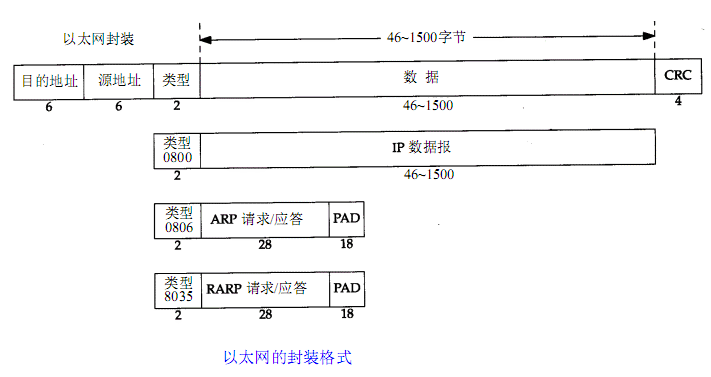Linux網路程式設計——原始套接字例項:MAC 頭部報文分析
通過《Linux網路程式設計——原始套接字程式設計》得知,我們可以通過原始套接字以及 recvfrom( ) 可以獲取鏈路層的資料包,那我們接收的鏈路層資料包到底長什麼樣的呢?
MAC 頭部(有線區域網)
注意:CRC、PAD 在組包時可以忽略
鏈路層資料包的其中一種情況:
unsigned char msg[1024] = { //--------------組MAC--------14------ 0xb8, 0x88, 0xe3, 0xe1, 0x10, 0xe6, // dst_mac: b8:88:e3:e1:10:e6 0xc8, 0x9c, 0xdc, 0xb7, 0x0f, 0x19, // src_mac: c8:9c:dc:b7:0f:19 0x08, 0x00, // 型別:0x0800 IP協議 // …… …… // …… …… };
接收的鏈路層資料包,並對其進行簡單分析: #include <stdio.h> #include <string.h> #include <stdlib.h> #include <sys/socket.h> #include <netinet/in.h> #include <arpa/inet.h> #include <netinet/ether.h> int main(int argc,char *argv[]) { int i = 0; unsigned char buf[1024] = ""; int sock_raw_fd = socket(PF_PACKET, SOCK_RAW, htons(ETH_P_ALL)); while(1) { unsigned char src_mac[18] = ""; unsigned char dst_mac[18] = ""; //獲取鏈路層的資料幀 recvfrom(sock_raw_fd, buf, sizeof(buf),0,NULL,NULL); //從buf裡提取目的mac、源mac sprintf(dst_mac,"%02x:%02x:%02x:%02x:%02x:%02x", buf[0], buf[1], buf[2], buf[3], buf[4], buf[5]); sprintf(src_mac,"%02x:%02x:%02x:%02x:%02x:%02x", buf[6], buf[7], buf[8], buf[9], buf[10], buf[11]); //判斷是否為IP資料包 if(buf[12]==0x08 && buf[13]==0x00) { printf("______________IP資料報_______________\n"); printf("MAC:%s >> %s\n",src_mac,dst_mac); }//判斷是否為ARP資料包 else if(buf[12]==0x08 && buf[13]==0x06) { printf("______________ARP資料報_______________\n"); printf("MAC:%s >> %s\n",src_mac,dst_mac); }//判斷是否為RARP資料包 else if(buf[12]==0x80 && buf[13]==0x35) { printf("______________RARP資料報_______________\n"); printf("MAC:%s>>%s\n",src_mac,dst_mac); } } return 0; }
記得以管理者許可權執行程式:
每個報文頭部都有一個相應的結構體,通過這些結構體對報文進行相應的組包或拆包會方便很多。
ubuntu 12.04 中描述網路協議結構的檔案如下:
乙太網頭部(所需要標頭檔案:#include <net/ethernet.h>):
上面的例子,改為用結構體實現,如下:
#include <stdio.h> #include <string.h> #include <stdlib.h> #include <sys/socket.h> #include <netinet/in.h> #include <arpa/inet.h> #include <netinet/ether.h> #include <net/ethernet.h> // 乙太網頭部 標頭檔案 #include <netinet/ip.h> // ip頭部 標頭檔案 // #include <net/if_arp.h> // arp頭部 標頭檔案 int main(int argc,char *argv[]) { int i = 0; unsigned char buf[1024] = ""; int sock_raw_fd = socket(PF_PACKET, SOCK_RAW, htons(ETH_P_ALL)); while(1) { unsigned char src_mac[18] = ""; unsigned char dst_mac[18] = ""; //獲取鏈路層的資料幀 recvfrom(sock_raw_fd, buf, sizeof(buf),0,NULL,NULL); //從資料中提取mac首部資訊(14個位元組) struct ether_header *ethdr = NULL; ethdr = (struct ether_header *)buf; //從buf裡提取目的mac、源mac sprintf(dst_mac,"%02x:%02x:%02x:%02x:%02x:%02x", ethdr->ether_dhost[0], ethdr->ether_dhost[1],ethdr->ether_dhost[2],ethdr->ether_dhost[3],ethdr->ether_dhost[4],ethdr->ether_dhost[5]); sprintf(src_mac,"%02x:%02x:%02x:%02x:%02x:%02x", ethdr->ether_shost[0], ethdr->ether_shost[1],ethdr->ether_shost[2],ethdr->ether_shost[3],ethdr->ether_shost[4],ethdr->ether_shost[5]); //判斷是否為IP資料包 if( 0x0800 == ntohs(ethdr->ether_type) ) { printf("______________IP資料報_______________\n"); printf("MAC:%s >> %s\n",src_mac,dst_mac); }//0x0806為ARP資料包, 0x8035為RARP資料包 else if( 0x0806 == ntohs(ethdr->ether_type) || 0x8035 == ntohs(ethdr->ether_type) ) { printf("______________ARP資料報_______________\n"); printf("MAC:%s >> %s\n",src_mac,dst_mac); } } return 0; }





